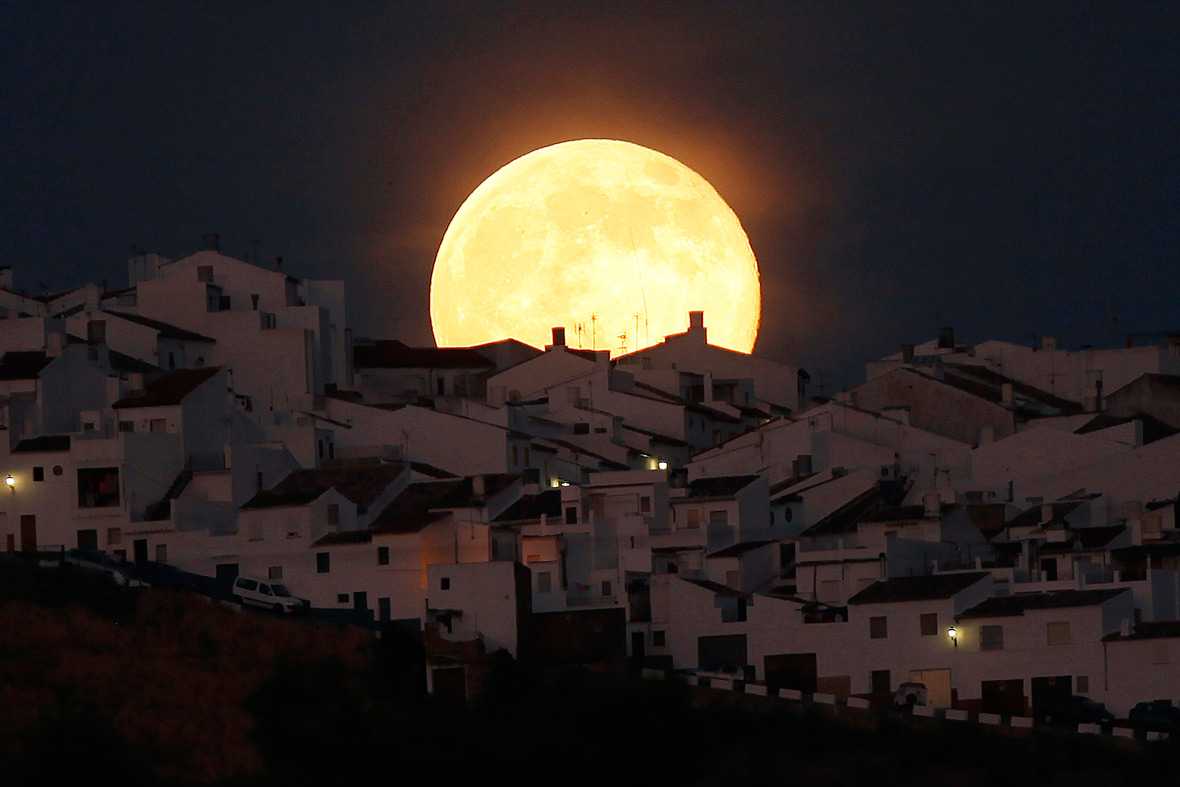Mar. 17th, 2015 at 11:41am
Solar eclipse, supermoon and spring equinox to coincide for extremely rare celestial treat

July 12 2014: The supermoon rises over houses in Olvera, in the southern Spanish province of Cadiz. Occurring when a full moon coincides with the closest approach the moon makes to the Earth, the supermoon results in a larger-than-usual appearance....
On Friday 20 March, parts of the UK (mostly Scotland) will see around 95% of the sun's light blocked out by the moon.
The last time the UK saw a solar eclipse was on 11 August 1999. This was the first total solar eclipse visible from the UK for over 70 years.
However, this solar eclipse will coincide with two other events – the perigee moon and the spring equinox.
Total eclipse
The total eclipse will best be viewed from the Faroe Islands in the Pacific, where 100% of the sun's light will be obscured for two minutes and 12 seconds.
The area of totality – where the total eclipse can be observed – lies within a wide corridor that sweeps across the Northern Atlantic, North Sea and Norwegian Sea. Other than the Faroe Islands, very few landmasses lie in the path. In the UK, the Isle of Lewis will see 98% coverage at 9.36am, while the Shetland Islands will see 97% coverage at 9.43am.
A solar eclipse occurs when the moon passes in front of the sun – the type of solar eclipse event (total, partial or annular) depends on the distance of the moon from our planet during the event. A total eclipse is where the Earth intersects the umbra portion of the moon's shadow.
Supermoon
Supermoons are more common than total eclipses. Also known as a perigee moon, they take place when the full or new moon is at its closest point to Earth, meaning the moon appears larger than normal. On the other end of the scale, an apogee moon is where the moon is at its farthest point from Earth. March's perigee moon will take place on 19 March, the day before the solar eclipse. The perigee moon is what causes the total eclipse.
The next supermoon will not appear until July but the best of the year will appear in September, when the moon will come within 356,877km of Earth.
Spring equinox
Spring equinox takes place on or around 20 March every year. It is where Earth's axis will be perpendicular to the sun, after which it will start moving over making the days longer in the Northern Hemisphere.
Although this has no impact on the other two events, it is extremely rare that they take place on the same day. The next time a solar eclipse will happen on 20 March will be 2053 and 2072.

July 12 2014: The supermoon rises over houses in Olvera, in the southern Spanish province of Cadiz. Occurring when a full moon coincides with the closest approach the moon makes to the Earth, the supermoon results in a larger-than-usual appearance....
On Friday 20 March, parts of the UK (mostly Scotland) will see around 95% of the sun's light blocked out by the moon.
The last time the UK saw a solar eclipse was on 11 August 1999. This was the first total solar eclipse visible from the UK for over 70 years.
However, this solar eclipse will coincide with two other events – the perigee moon and the spring equinox.
Total eclipse
The total eclipse will best be viewed from the Faroe Islands in the Pacific, where 100% of the sun's light will be obscured for two minutes and 12 seconds.
The area of totality – where the total eclipse can be observed – lies within a wide corridor that sweeps across the Northern Atlantic, North Sea and Norwegian Sea. Other than the Faroe Islands, very few landmasses lie in the path. In the UK, the Isle of Lewis will see 98% coverage at 9.36am, while the Shetland Islands will see 97% coverage at 9.43am.
A solar eclipse occurs when the moon passes in front of the sun – the type of solar eclipse event (total, partial or annular) depends on the distance of the moon from our planet during the event. A total eclipse is where the Earth intersects the umbra portion of the moon's shadow.
Supermoon
Supermoons are more common than total eclipses. Also known as a perigee moon, they take place when the full or new moon is at its closest point to Earth, meaning the moon appears larger than normal. On the other end of the scale, an apogee moon is where the moon is at its farthest point from Earth. March's perigee moon will take place on 19 March, the day before the solar eclipse. The perigee moon is what causes the total eclipse.
The next supermoon will not appear until July but the best of the year will appear in September, when the moon will come within 356,877km of Earth.
Spring equinox
Spring equinox takes place on or around 20 March every year. It is where Earth's axis will be perpendicular to the sun, after which it will start moving over making the days longer in the Northern Hemisphere.
Although this has no impact on the other two events, it is extremely rare that they take place on the same day. The next time a solar eclipse will happen on 20 March will be 2053 and 2072.





